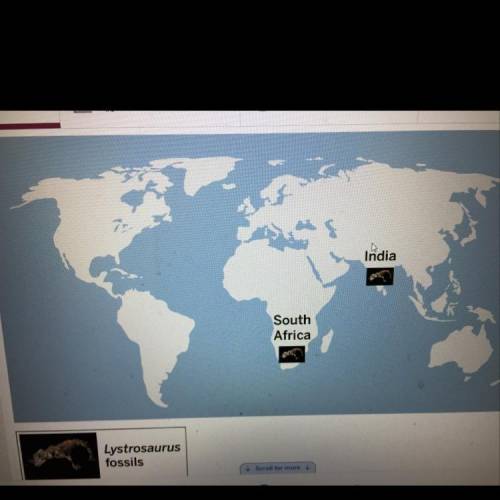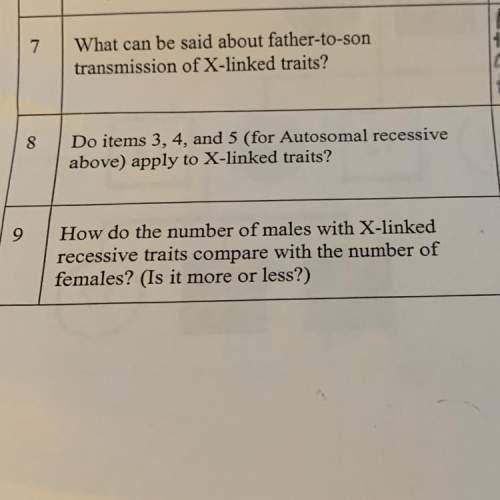
Biology, 23.03.2020 15:59 amortegaa805
Fossil remains of Lustrosaurus (an extinct four-legged animal) have been discovered in India and
South Africa. When they were living, all the Lystrosaurus lived together on land, and they could not
swim. However, now there is an ocean between the Lystrosaurus fossils. What could explain how
these fossils got so far apart?
A. India and South Africa are parts of different plates. The plates slowly moved far apart as
soft, solid rock from underneath got added to the edges of the plates over millions of years.
B. India and South Africa are parts of different plates. The plates floated away from each other
across the ocean.
C. India and South Africa are parts of different plates. The plates slowly moved apart as new
plates from underneath got added between them over millions of years.
D. India and South Africa are parts of different plates. The plates were sometimes pushed far
apart by earthquakes, and soft, solid rock from underneath got added to the edges of the
plates.


Answers: 3
Another question on Biology

Biology, 21.06.2019 18:00
The phlogiston theory in the 17th century attempted to explain burning. the theory stated that combustable objects contained a material called phlogiston, a substance without mass, color, odor, etc. after objects burned, the objects were dephlogistonated and were then in their true form. the phlogiston theory was accepted until the 18th century, when lavoisier proved that combustion requires a gas that has mass. phlogiston is considered a) to be scientific knowledge b) not to be scientific knowledge c) to be proven by scientific method d) to be accepted in the modern scientific community
Answers: 2

Biology, 21.06.2019 21:00
1. environmental factors, such as ph and temperature, can affect the function of an enzyme. a. true b. false 2. which of the following is an organic molecules (ex. vitamins) that an enzyme? a. coenzyme b. product c. active site d. substrate 3. how do enzymes effect the speed of a chemical reaction? a. they speed it up b. they slow it down c. they have no effect on the speed of a reaction 4. during a chemical reaction, an enzyme is used up so that it can only be used one time. a. true b. false 5. which of the following results from a chemical reaction that is catalyzed by an enzymes? a. active site b. product c. substrate d. coenzyme
Answers: 3

Biology, 22.06.2019 06:50
The kidney filters potentially toxic substances in the blood, and thus “clears” the blood of those substances. this clearance function is dependent upon and proportional to the diffusion gradient of the substance across filtering capillaries, i.e. if the concentration of the substance is doubled, twice as much will be cleared from each ml of blood that is filtered. suppose that the body produces a constant amount of a substance x per unit of time. the kidneys eliminate substance x at a rate directly proportional to the concentration of the substance and the volume of blood cleared each minute (c): elimination = c × [x], where [x] is the steady-state concentration of substance x. imagine an individual with an initial concentration of x equal to [x]0 who develops kidney disease. her baseline clearance c0 drops to one half of the original (½c0). what is the new steady state concentration of x? (for simplicity, assume that substance x is 100% filtered by the kidney).
Answers: 1

Biology, 22.06.2019 13:10
The importance of the mind as a part of the body is an example of:
Answers: 1
You know the right answer?
Fossil remains of Lustrosaurus (an extinct four-legged animal) have been discovered in India and
Questions


Mathematics, 29.06.2020 17:01

Computers and Technology, 29.06.2020 17:01

Mathematics, 29.06.2020 17:01

Mathematics, 29.06.2020 17:01

English, 29.06.2020 17:01


English, 29.06.2020 17:01

Mathematics, 29.06.2020 17:01

Mathematics, 29.06.2020 17:01


Mathematics, 29.06.2020 17:01

Mathematics, 29.06.2020 17:01

English, 29.06.2020 17:01

Biology, 29.06.2020 17:01



Mathematics, 29.06.2020 17:01

Mathematics, 29.06.2020 17:01

Chemistry, 29.06.2020 17:01




